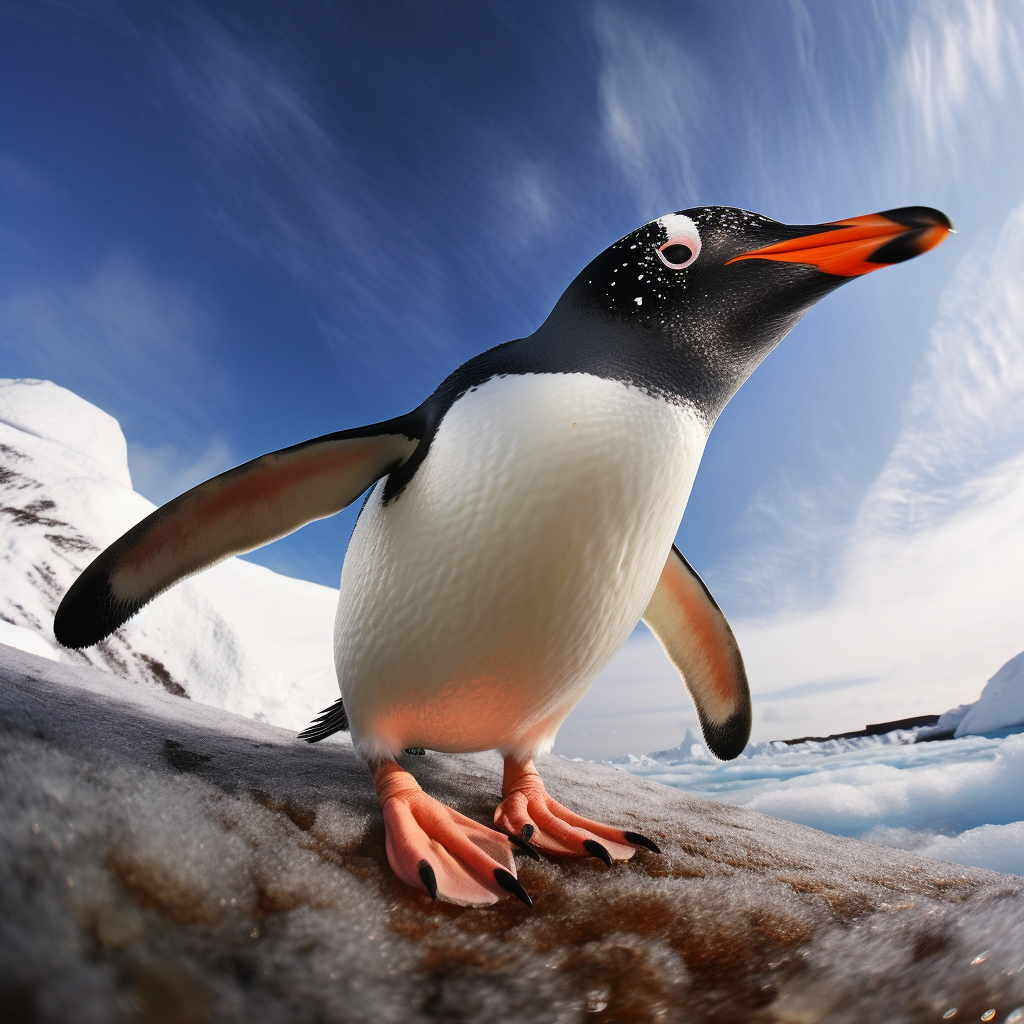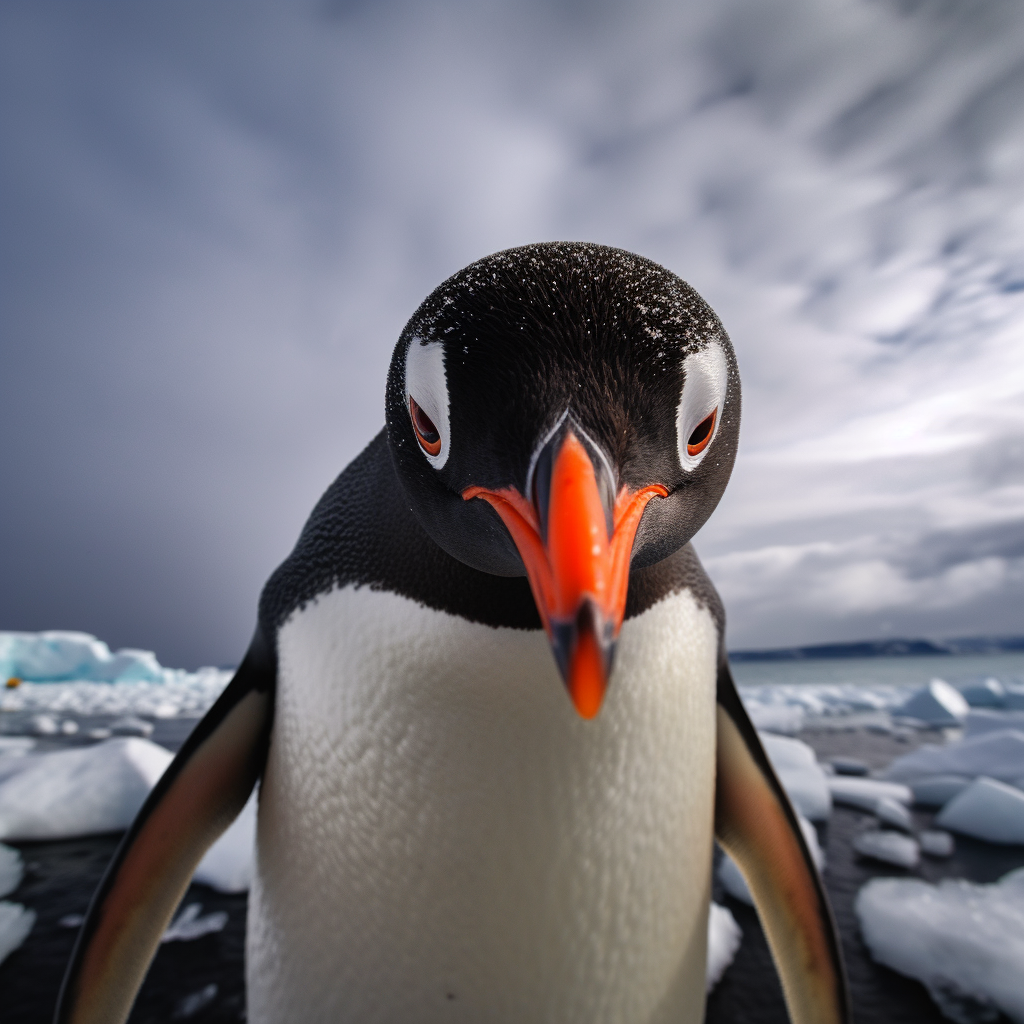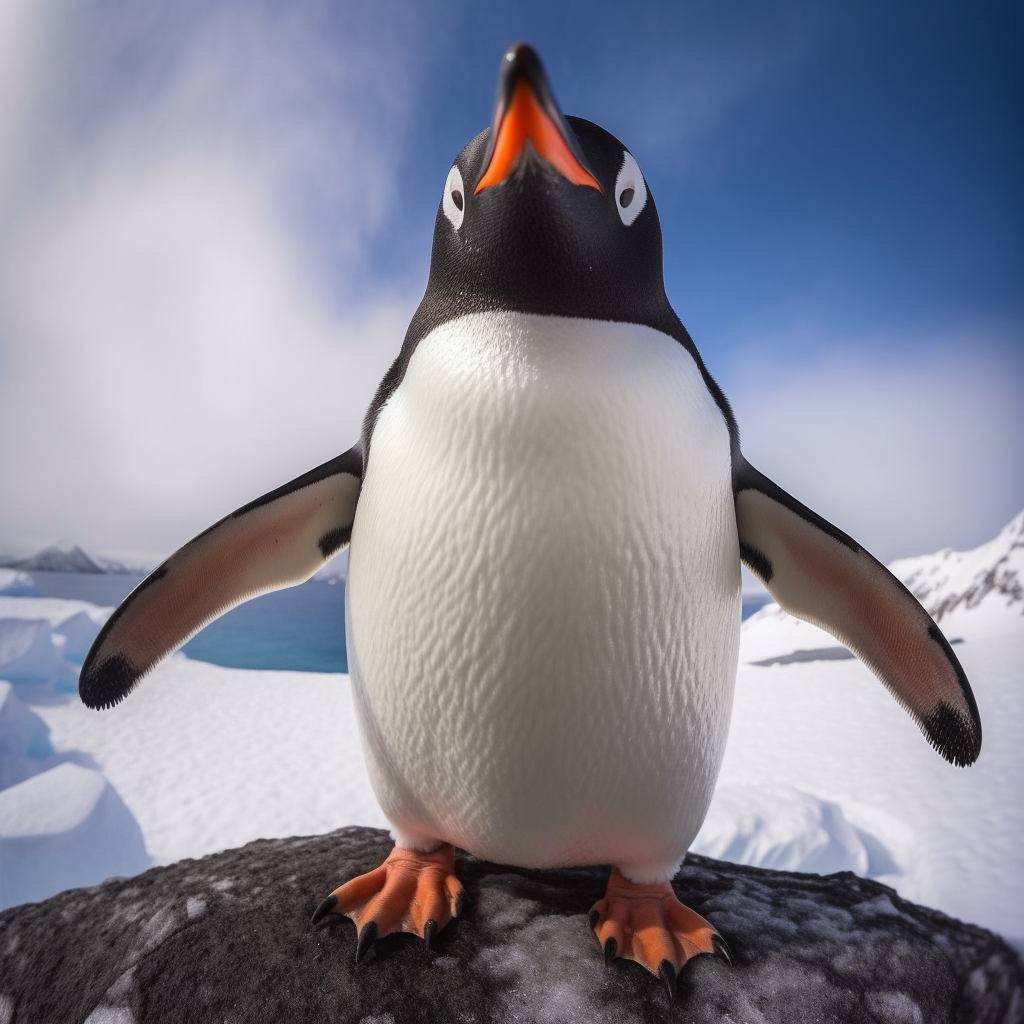The Gentoo Penguin is a fascinating species of penguin that inhabits the Antarctic region. Known for its distinctive appearance and charming personality, the Gentoo Penguin is one of the most recognizable and beloved penguin species in the world. With its sleek black and white feathers, bright orange-red beak, and striking white patch above its eyes, the Gentoo Penguin stands out among its counterparts. These remarkable creatures are known for their agility in the water, where they spend a significant portion of their lives hunting for fish and other marine creatures. Despite their small stature, Gentoo Penguins are excellent swimmers and can reach impressive speeds of up to 22 miles per hour (35 kilometers per hour). In addition to their exceptional swimming abilities, Gentoo Penguins are also skilled on land, using their strong flippers to navigate rocky terrain and build nests made of stones and vegetation. These nests serve as a safe haven for their eggs and chicks, protecting them from the harsh Antarctic climate. With their playful nature and distinctive call, Gentoo Penguins are a delight to observe in their natural habitat. Join us as we dive into the fascinating world of Gentoo Penguins and explore their unique characteristics, behaviors, and the challenges they face in their icy home.
Key Takeaways
- Gentoo penguins are a species of penguin found in the Antarctic region.
- They are known for their distinctive orange beaks and long tails.
- Gentoo penguins are excellent swimmers and can reach speeds of up to 22 miles per hour.
- They primarily feed on krill, fish, and squid.
- These penguins build nests out of stones and pebbles on rocky shores.
- Gentoo penguins are monogamous and mate for life.
- Climate change and human activities pose threats to the population of Gentoo penguins.
Understanding the Gentoo Penguin: An Overview

A. What is a Gentoo Penguin?
The Gentoo Penguin (Pygoscelis papua) is a fascinating species of penguin that belongs to the family Spheniscidae. Known for their distinctive appearance and unique behaviors, Gentoo Penguins are native to the subantarctic islands and the Antarctic Peninsula. They are one of the largest penguin species, standing at around 20 inches tall and weighing between 12 to 17 pounds.
B. Gentoo Penguin Characteristics
Gentoo Penguins are easily recognizable due to their striking physical features. They have a white patch on their head that extends from their eyes to the back of their head, contrasting with their black feathers on the rest of their body. One of the most distinctive characteristics of the Gentoo Penguin is their bright orange-red beak, which adds a vibrant pop of color to their appearance. Additionally, they have long, narrow tails and strong, webbed feet that make them excellent swimmers.
C. Gentoo Penguin Habitat: Where are Gentoo Penguins Found?
Gentoo Penguins primarily inhabit the subantarctic islands and the Antarctic Peninsula. They can be found on islands such as South Georgia, the Falkland Islands, and the Kerguelen Islands. These regions provide the ideal conditions for Gentoo Penguins, with a combination of rocky shores, sandy beaches, and plenty of open water for foraging. They are well adapted to the cold climate and are often seen in large colonies, nesting on rocky slopes or in tussock grass.
D. The Unique Appearance: What Does a Gentoo Penguin Look Like?
The Gentoo Penguin has a distinct appearance that sets it apart from other penguin species. They have a sleek, streamlined body that is perfectly adapted for swimming through the icy waters of the Southern Ocean. Their black and white plumage helps them blend in with their surroundings, providing camouflage from predators such as leopard seals and orcas. The bright orange-red beak and the white patch on their head add a touch of color to their overall appearance, making them truly captivating to observe.
E. The Sound of the Sea Bird: How Do Gentoo Penguins Sound?
Gentoo Penguins are known for their vocalizations, which play a crucial role in their social interactions. They produce a variety of sounds, including trumpeting calls, braying, and honking. These vocalizations serve different purposes, such as attracting a mate, defending territory, or communicating with their chicks. The calls of Gentoo Penguins can be heard echoing across the breeding colonies, creating a symphony of sounds that is both mesmerizing and unique to these charismatic sea birds.
In conclusion, the Gentoo Penguin is a remarkable species that thrives in the subantarctic and Antarctic regions. With their striking appearance, unique behaviors, and captivating vocalizations, they have become a symbol of the incredible diversity of wildlife found in these remote and icy habitats. Understanding the characteristics and habitat of Gentoo Penguins allows us to appreciate the beauty and resilience of these fascinating creatures.
The Life Cycle of the Gentoo Penguin
The Gentoo Penguin, a fascinating species of penguin found in the Antarctic and Subantarctic regions, goes through a remarkable life cycle. From mating rituals to the growth of their chicks, each stage is filled with unique behaviors and challenges. Let’s explore the different phases of the Gentoo Penguin’s life cycle.
A. The Mating Rituals: How Do Penguins Mate?
Mating rituals among Gentoo Penguins are a sight to behold. These social birds form large colonies where they engage in courtship displays to attract a mate. The males are known for their elaborate displays, which involve head bobbing, calling, and flapping their flippers.
Once a pair has formed, they engage in a bonding ritual known as the “ecstatic display.” This involves the male stretching his neck upwards and emitting a loud call, while the female responds with a similar call. This display strengthens the bond between the pair and prepares them for breeding.
B. The Pebble Proposal: A Unique Gentoo Penguin Behavior
One of the most intriguing behaviors of Gentoo Penguins is their use of pebbles in the mating process. After the pair has bonded, the male searches for the perfect pebble to present to the female as a gift. This act is a symbolic proposal, indicating the male‘s readiness to mate and start a family.
The male carefully selects a smooth, round pebble and presents it to the female. If she accepts the pebble, it signifies her acceptance of the male‘s proposal. The pair then proceeds to build a nest together using more pebbles, sticks, and other materials.
C. Laying and Hatching: When Do Gentoo Penguins Lay Eggs?
After the nest is constructed, the female Gentoo Penguin lays one or two eggs. The timing of egg-laying varies depending on the location, but it typically occurs between October and November in the Antarctic and between November and December in the Subantarctic.
Both parents take turns incubating the eggs, with each shift lasting around 24 to 48 hours. During this period, the parents carefully protect the eggs from predators and harsh weather conditions. The incubation period lasts for about 34 to 36 days, after which the eggs hatch.
D. The Growth of a Chick: From Gentoo Penguin Baby to Adult
Once the eggs hatch, the Gentoo Penguin chicks enter the world. They are covered in soft, gray down feathers and rely on their parents for warmth and protection. The parents take turns feeding the chicks, regurgitating food from their stomachs to nourish them.
As the chicks grow, they develop a waterproof plumage, which replaces their down feathers. This process, known as molting, allows them to venture into the water and learn how to swim and hunt for food. The parents continue to care for and feed the chicks until they are old enough to fend for themselves.
The growth of a Gentoo Penguin chick is a gradual process that takes several months. By the time they reach adulthood, they are fully independent and ready to start their own journey in the Antarctic or Subantarctic waters.
In conclusion, the life cycle of the Gentoo Penguin is a remarkable journey filled with unique behaviors and adaptations. From the elaborate mating rituals to the nurturing of their chicks, these penguins demonstrate incredible resilience and dedication to their species’ survival. Understanding their life cycle is crucial for conservation efforts and ensuring the long-term survival of this magnificent species.
The Survival Skills of the Gentoo Penguin

A. Adaptations to the Cold: How Do Penguins Survive in the Cold?
Gentoo Penguins are remarkable creatures that have evolved a range of adaptations to thrive in the harsh and icy conditions of the Antarctic and Subantarctic regions. These adaptations allow them to survive in temperatures that would be unbearable for most other animals.
One of the most important adaptations of the Gentoo Penguin is its thick layer of blubber, which acts as insulation against the cold. This layer of fat helps to keep the penguin warm by providing a barrier between its body and the freezing water. Additionally, the penguin‘s feathers are tightly packed and waterproof, which helps to keep it dry and prevent heat loss.
To further combat the cold, Gentoo Penguins have developed a unique circulatory system. Their blood vessels are arranged in a way that allows warm blood to flow past cold blood, minimizing heat loss. This adaptation ensures that the penguin‘s vital organs receive a constant supply of warm blood, even in freezing temperatures.
B. The Art of Movement: How Do Penguins Walk and Swim?
Gentoo Penguins are known for their agility both on land and in the water. On land, they use a distinctive waddling gait, where they rock from side to side as they walk. This waddling motion helps them maintain balance and conserve energy while navigating the uneven terrain of their breeding colonies.
When it comes to swimming, Gentoo Penguins are excellent divers. They use their wings, which have evolved into powerful flippers, to propel themselves through the water. These flippers allow them to reach impressive speeds of up to 22 miles per hour (35 kilometers per hour). Their streamlined bodies and webbed feet also contribute to their swimming prowess, enabling them to maneuver effortlessly through the water in search of food.
C. Feeding Habits: What Do Gentoo Penguins Eat and When?
Gentoo Penguins are opportunistic feeders, meaning they will eat whatever food is available to them. Their diet primarily consists of krill, small fish, and squid. They are skilled hunters and can dive to depths of up to 655 feet (200 meters) in search of their prey.
During the breeding season, Gentoo Penguins rely heavily on their foraging abilities to provide food for their chicks. Both parents take turns going out to sea to hunt for food, returning to the colony with a belly full of fish or krill. They regurgitate this food to feed their hungry chicks, ensuring their survival and growth.
D. How Do Penguins Breathe: The Underwater Mystery
One of the most fascinating aspects of the Gentoo Penguin’s survival skills is its ability to breathe while underwater. Unlike humans, penguins can hold their breath for extended periods of time, allowing them to dive deep in search of food.
When a Gentoo Penguin dives, it slows down its heart rate and redirects blood flow away from non-essential organs, such as the digestive system, and towards the brain and muscles. This conservation of oxygen enables the penguin to stay submerged for several minutes at a time.
To extract oxygen from the water, Gentoo Penguins have developed a specialized respiratory system. They have a higher concentration of myoglobin, a protein that stores oxygen in the muscles, which allows them to extract more oxygen from each breath. Additionally, their lungs are highly efficient at extracting oxygen from the air, ensuring that they can replenish their oxygen supply quickly when they return to the surface.
In conclusion, the Gentoo Penguin’s survival skills are a testament to its remarkable adaptations and abilities. From its ability to withstand the cold to its agile movements on land and in the water, this species has evolved to thrive in its unique environment. Its feeding habits and underwater breathing techniques further highlight its resilience and resourcefulness. The Gentoo Penguin is truly a fascinating creature that continues to captivate researchers and wildlife enthusiasts alike.
The Threats and Challenges Faced by Gentoo Penguins
A. Predators of the Gentoo Penguin: What Eats Gentoo Penguins?
Gentoo penguins, like many other species, face a range of threats and challenges in their natural habitat. One of the most significant challenges they encounter is the presence of predators. In the harsh Antarctic and Subantarctic environments where Gentoo penguins reside, they have to constantly be on guard against potential predators.
Several predators pose a threat to Gentoo penguins, especially during their breeding season when they are most vulnerable. One of the primary predators of Gentoo penguins is the leopard seal. These formidable marine predators are known for their agility and stealth, making them a formidable threat to penguins. Leopard seals are skilled hunters, capable of ambushing penguins as they enter or exit the water. They can also snatch penguins from the surface of the ice, making it difficult for these flightless birds to escape.
Another predator that poses a threat to Gentoo penguins is the South American sea lion. These large marine mammals are known to prey on penguins, particularly when they are swimming near the coastline. Sea lions are powerful swimmers and can easily catch penguins in the water. They are especially skilled at hunting penguin chicks, which are more vulnerable due to their smaller size and lack of experience.
B. Why are Gentoo Penguins Endangered?
Gentoo penguins are currently classified as a species of “Least Concern” on the IUCN Red List, which means they are not currently considered endangered. However, this does not mean they are completely safe from threats. The overall population of Gentoo penguins is relatively stable, but localized declines have been observed in some regions.
One of the main reasons why Gentoo penguins face potential endangerment is the impact of climate change. As global temperatures rise, the Antarctic and Subantarctic regions are experiencing significant changes in their ecosystems. These changes can affect the availability of food sources for Gentoo penguins, as well as the stability of their breeding habitats. Climate change can also lead to the melting of sea ice, which is essential for penguins to access their feeding grounds.
Human activities also pose a threat to Gentoo penguins. Increased tourism in penguin breeding areas can disrupt their natural behavior and cause stress. Pollution from oil spills and fishing activities can also have detrimental effects on penguin populations. Additionally, the introduction of non-native species to the penguins’ habitats can disrupt the delicate balance of the ecosystem and negatively impact their survival.
C. The Current Population: How Many Gentoo Penguins are Left in the World?
Estimating the exact population of Gentoo penguins is a challenging task due to their scattered distribution across the Antarctic and Subantarctic regions. However, researchers have conducted studies to estimate their numbers, providing valuable insights into the current population status.
According to the most recent estimates, the global population of Gentoo penguins is believed to be around 387,000 breeding pairs. These estimates indicate that Gentoo penguins have a relatively healthy population size compared to some other penguin species. However, it is important to note that population numbers can vary significantly between different colonies and regions.
Efforts are underway to monitor and conserve Gentoo penguin populations. Researchers and conservation organizations are conducting studies to better understand their behavior, breeding patterns, and habitat requirements. By gathering this information, conservationists can develop strategies to protect and preserve the species.
In conclusion, while Gentoo penguins face threats and challenges, they are not currently classified as endangered. Predators such as leopard seals and South American sea lions pose a risk to their survival, and climate change and human activities also contribute to their vulnerability. However, with ongoing research and conservation efforts, there is hope for the continued survival of these fascinating creatures.
Interesting Facts about the Gentoo Penguin

A. The Speed of the Gentoo Penguin: On Land and In Water
The Gentoo Penguin is known for its impressive speed both on land and in water. These agile creatures can reach speeds of up to 22 miles per hour (35 kilometers per hour) when swimming, making them one of the fastest penguin species. Their streamlined bodies and strong flippers allow them to glide effortlessly through the water, enabling them to catch fish and other prey with ease.
On land, Gentoo Penguins may not be as fast as their swimming counterparts, but they can still move at a brisk pace. They waddle along using a combination of their webbed feet and flippers, which helps them maintain balance and stability. Despite their seemingly awkward gait, they can cover significant distances when traveling between their nesting sites and the ocean.
B. The Gentoo Penguin’s Pebble: A Symbol of Love
One of the most fascinating aspects of Gentoo Penguin behavior is their use of pebbles as a symbol of love and courtship. Male Gentoo Penguins will search for the perfect pebble to present to their chosen mate. These pebbles are carefully selected based on their size, shape, and color.
Once a male penguin finds a suitable pebble, he will present it to the female as a token of his affection. If she accepts the pebble, it signifies that she is interested in forming a bond with him. The pair will then use the pebble to build their nest together, reinforcing their bond and creating a safe space for their future chicks.
C. The Longevity of the Gentoo Penguin: How Long Do They Live?
Gentoo Penguins have a relatively long lifespan compared to other penguin species. On average, they can live up to 15 to 20 years in the wild. However, some individuals have been known to live even longer, with the oldest recorded Gentoo Penguin reaching an impressive age of 33 years.
The longevity of these penguins can be attributed to their ability to adapt to their environment and their strong survival instincts. They have developed various adaptations that allow them to thrive in the harsh Antarctic and Subantarctic conditions, such as their waterproof feathers, efficient thermoregulation, and excellent swimming abilities.
D. The Gentoo Penguin Tattoo: A Symbol of Strength and Survival
The Gentoo Penguin has become an iconic symbol of strength and survival, inspiring many people to get tattoos depicting these remarkable creatures. These tattoos often showcase the Gentoo Penguin’s distinctive features, such as its bright orange bill, white-feathered cap, and sleek black body.
People choose to get Gentoo Penguin tattoos as a way to symbolize their own resilience and ability to overcome challenges. The penguins’ ability to adapt to extreme environments and their strong sense of community resonate with individuals who value determination, perseverance, and the power of unity.
In conclusion, the Gentoo Penguin is a fascinating species with unique characteristics and behaviors. From their impressive speed in the water to their use of pebbles as a symbol of love, these penguins continue to captivate the hearts and minds of people around the world. Their longevity and ability to survive in harsh conditions serve as a testament to their strength and resilience. Whether it’s through tattoos or simply observing them in their natural habitat, the Gentoo Penguin reminds us of the beauty and diversity of the natural world. Conclusion
In conclusion, the Gentoo Penguin is a fascinating and resilient species that inhabits the Antarctic region. With its distinctive appearance, including its bright orange bill and white-feathered cap, the Gentoo Penguin stands out among its counterparts. These penguins are known for their excellent swimming and diving abilities, allowing them to forage for food in the frigid waters. They also exhibit interesting nesting behaviors, constructing nests out of pebbles and engaging in courtship rituals to attract a mate. Despite facing challenges such as climate change and human activity, the Gentoo Penguin has shown remarkable adaptability and resilience. Conservation efforts are crucial to ensure the survival of this remarkable species and to maintain the delicate balance of the Antarctic ecosystem. By raising awareness and taking action to protect their habitat, we can help secure a future for the Gentoo Penguin and the diverse array of life that depends on it.
Frequently Asked Questions
How do penguins survive in the cold?
Penguins are well adapted to survive in the cold Antarctic environment. They have a layer of fat under their skin called blubber that insulates them from the cold. They also have waterproof feathers that provide an additional layer of insulation.
How do penguins eat?
Penguins eat by catching their prey (usually krill, fish, and squid) in their beak while swimming. They have a spiky tongue and roof of the mouth that help them grip their slippery prey.
When do Gentoo penguins eat?
Gentoo penguins typically eat during the day. They dive to catch their prey and can make multiple feeding trips per day.
What is the speed of a Gentoo penguin?
Gentoo penguins are the fastest swimming penguin species. They can reach speeds of up to 22 miles per hour (36 kilometers per hour) in the water.
What are some adaptations of the Gentoo penguin?
Gentoo penguins have several adaptations that help them survive in their harsh environment. These include a streamlined body for efficient swimming, a thick layer of insulating feathers, and a counter-shaded coloration that helps them avoid predators.
How do you pronounce ‘Gentoo penguin’?
‘Gentoo penguin‘ is pronounced as ‘jen-too pen-gwin‘.
What do Gentoo penguins look like?
Gentoo penguins are medium-sized penguins with a distinctive orange-red bill and a white patch over the eye that extends to the back of the head. They have a black back and white belly.
What sound does a Gentoo penguin make?
Gentoo penguins make a variety of sounds for communication, including loud trumpeting calls, soft contact calls, and aggressive calls. The trumpeting call, which sounds like a donkey braying, is often used in mating displays.
Where are Gentoo penguins found?
Gentoo penguins are found on the Antarctic Peninsula and surrounding islands, as well as on some subantarctic islands.
How do penguins move?
Penguins move on land by walking or hopping, using their flippers for balance. They can also slide on their bellies, a movement known as tobogganing, which allows them to move quickly over the ice. In water, they swim using their flippers for propulsion and their feet and tail for steering.




